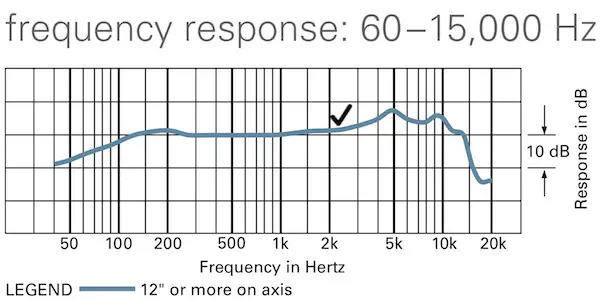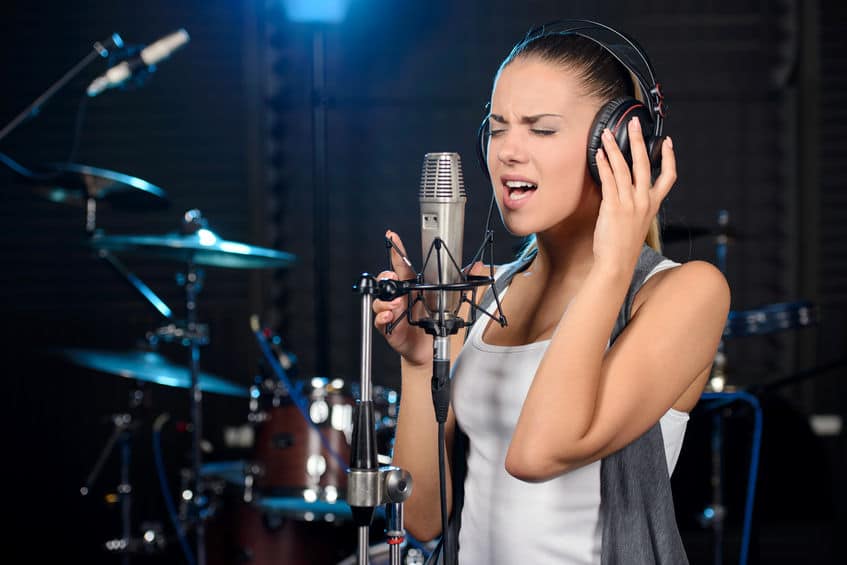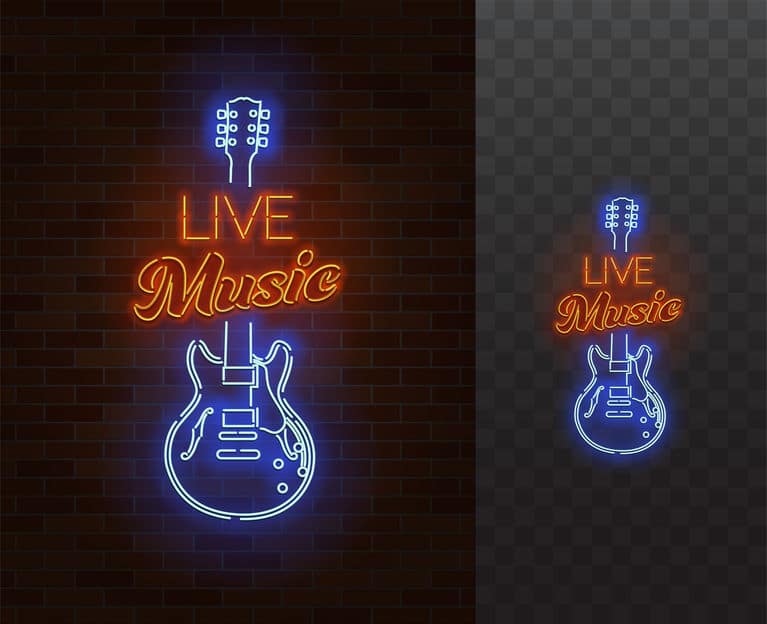When you think of Live music, what are the words that you would use to describe that sound? Emotional, exciting, and dynamic? Vocal Mics are the tools needed to deliver that powerful live type of sound. What do Mics need for Live Performance?
A Live Mic needs:
- To Be a Large Diaphragm-To pick up more sound & a wider frequency
- Be a Dynamic Mic-absorb peak Highs & Lows
- Be Cardioid ( Hypercardioid or Supercardioid)
- Polar patterns that reject bleeding from other voices & instruments.
- To handle high Sound Pressure Levels (SPLs)
- Have Wide Frequency Response
Got a gig this weekend? What kind of microphone will you need to make the band sound great, read this article for the best advice on Mics that need certain characteristics for playing live on stage
Best Microphone for Live Vocals
Large Diaphragm microphones will pick up more sound It should evoke emotions that are triggered by those sounds that are being delivered by the musician or musicians playing together as one. Some of the sounds are produced or accented by the crowd in the audience. They are considered the best recording microphone.
The Best Microphone for Vocals will amplify and detail those sounds without taking anything away. The right type of mic will capture higher levels of frequency response that’s delivered from the voice and the area directly around in close proximity to the voice.
The Dynamic Microphone that is will do this for a singer or an amplifier. They are workhorse mics that can absorb a lot of booms from the lower-end instruments and higher-end frequencies that come from a live setting.
- Cardioid means the sound is picked up in a heart-shaped pattern. The voice would be picked up mostly in the front region and a lesser around the parameter of the sides and rear so the field of amplification is shaped like a heart.
- The Microphone is Unidirectional meaning that the recording device located in the mic itself works from one direction. This excludes any background noise from offstage or on stage. If the vocalist is upon his mic the crowd will be hearing mostly him.
Dynamic Microphones are the most common type of mic. Inside a Dynamic mic is a very thin diaphragm that moves in response to sound pressure. The diaphragm is what we talked about in my first article. The diaphragm helps create or convert the small electric current or audio signals from the acoustic voice which are sound waves.
The Dynamic mic has a robust construction and is equipped to handle the bigger stage and outside concerts. Because of their simpler working design, they won’t produce like the more exact and precise microphones and have a flatter response but will hold up for years longer than the more expensive models.
The most famous and largely used mics all around the world for years are the Sure 57 & 58. They are known for consistent quality sound from any source along with the durability that they are widely known for.
The Shure 57 & 58 mics are known for their signature frequency response and presence boost that naturally comes with using them. The 57 and 58 Dynamic mics can be used just on about anything from snare drums to vocals. You can drop them a hundred times and they’ll still work too.
Trust me on that. Whenever Live playing or touring is part of the music Shure’s construction is very valuable for being number one for that reason. Dynamic mics with cardioid patterns can alleviate problems with feedback, especially in the middle of peak higher volumes which are bound to happen during live play.
No matter what dynamic mic you choose, you need a tight cardioid pattern with a wideband frequency and response. Dynamic microphones lose midrange and higher frequencies so placement is critical. In some situations, the most expensive might not be the best.
In some situations, the most expensive might not be the best Microphone for Vocals. On stage keep the Dynamic mic close to the source a few inches even the closer the better. Use a unidirectional mic to reduce feedback from other mics on stage. Again Cardioid Supercardioiod or hyper-cardioid Most directional mics will boost the bass when you mic up close.
It will also provide gain without feedback. You can get rid of excess bass at the mixer and keep the volume. So on stage place mics up close. This is only for the miking amps you don’t want mike up too close to a musical instrument. They are meant to be miked about a foot or two away for a better natural response
Some live players use a combination of pickups and miking their instruments to get a smooth rich wide frequency. The two methods are mixed in at the mixing board and provide a nice loud punchy but smooth but natural sound that’s not lost as it is sometimes when just a pickup is used on an acoustic instrument. I always found that to be true that miking instruments always sounded better than pickups on stage.
Dynamic Microphones like Shure 57 & 58 are the standards in the Industry for Dynamic microphones and there are a few more that are worth talking about. The bottom line is for live playing Dynamic mics like 57 & 58’s have a wide frequency range and a high SPL (sound pressure level) that is needed playing live and is considered the best recording microphone. They’re durable and reliable and constructed and tough to be used outdoors and in higher frequencies where the sound is more uncontrolled.
Thanks to their moving coil magnetic diaphragm construction, Dynamic mics can reliably capture sound at high sound pressure levels that you would expect to find at a live high-energy stage event.
Dynamic microphones can use them for miking loud sound sources like bass and guitar amplifiers, and even drum kits without worrying about unwanted distortion or damage. They are not just for high SPL applications, they will work quite well in quieter settings.
Diaphragm Microphones
So far we looked at the different features that separate microphones from each other Live music demand characteristics and features but the vocalist will be the final say.
- Dynamic Microphone for durability and pure sound quality.
- Unidirectional Microphone for keeping the sound isolated to a specific target that improves nuances and keeps the sound natural.
- Cardioid, Hypercardioiod, or Superhypercardioiod. specific polar patterns to capture sounds that are wanted and eliminate background sounds that are not wanted. This improved isolation also helps with potential feedback from anywhere on the stage and sound monitors.
The next characteristic of the Best Microphone for Vocals is Diaphragm size. All microphones pick up sound waves through their Diaphragms. These diaphragms are made up of a material that vibrates when sound waves come in contact with them.
This material converts that sonic energy into electrical energy. There are three different types of Diaphragm sizes small medium and large. The size of the Diaphragm will affect the SPL or sound pressure level handling, sensitivity dynamic range, and internal noise level.
Small Diaphragm or pencil mics are thin cylindrical-shaped microphones that are used to mic hi-hats or acoustic guitars. Their thin design makes them easier to work in tighter spaces like the soundhole of an acoustic guitar. Although they are thinner in design they are engineered to record in a wider frequency range and can handle SPL.
There is a spectacular pencil microphone with excellent performance capabilities. I use an AKG 170 that has a pad that cuts the amount of voltage coming from the mic to the mics internal amplifier. The bigger the Diaphragm the more it can sense the more it can capture vibrations in the air around it.
Large Diaphragm microphones will pick up more sound from the air around the mic and are not as stiff as the thinner pencil mics. Large Diaphragms can detect faint differences in sound pressure. This will result in more of a transparent and natural sound. Large Diaphragm mics are the standard in Studios and USM configurations in Home Recording.
Medium Diaphragm mics have some of the warmth and fullness that the larger ones have with the added higher frequencies that the small Diaphragm microphones have.
In a situation where the noise on stage can get loud and feedback suppression is important especially in smaller clubs and venues then try different Dynamic microphones starting out at cheaper prices.
For Vocals, let the singer get on top of the mic and you will hear what it can do. The Proximity Effect should have no bearing on the lead vocalist of a band performing on stage, as most vocalists are kissing the mic anyway. Some mics are interchangeable when it comes to live play and recording so experiment with some even with a few Condensor mics that can be used in both applications.
These are some Dynamic Microphones that have a good reputation for live playing and won’t break the bank and are considered the best microphone for singing.
Best Wireless Microphone for Vocals
Wireless Microphones Systems took a while before they became reliable and priced decently. They used to be plagued by drop-offs and interference. The new systems are relatively free from all those bad things that held us back from switching over.
One of the things to consider when buying a wireless mic system is the range. A rule of thumb for the wireless range is 2x the distance you can see the receiver from wherever you are using the mic. Most are around 150 feet which is plenty. The number of channels should equal the number of microphones.
If you are using 20 mics simultaneously you should have 20 channels. Frequencies need to be changed if needed. Two frequencies won’t work if the sound systems are too close. The best and newest wireless systems are Analogue for worship and stage systems Analogue is better.
Microphones tend to get really cheap in these systems. Go the extra bucks and buy a well-respected more expensive microphone with the Wireless System. Don’t try and save money here you’ll get what you pay for.
FCC compliance rules affect Wireless Microphone Systems. In 2020 new rules will take effect in wireless products. Make sure you don’t buy a discount system that won’t be regulated after 2020.
All systems are required to operate outside 617-652 MHz and 663-698 MHz by then. If yours does, you are good to go. The best advice from the pro’s when picking out one of these systems is to remember that the mic capsules that come with the system suffer in the lower-priced units.
Best Microphone for Singing Live
- Shure 57 & 58 Dynamic Microphone is the ultimate stage microphone that can mic your guitar amp on the first set and you can switch it over to a lead vocalist for the second set. They are just versatile and have been that way forever. I used them in Grammer school and found a 57 in the closet recently and plugged it in and used it for a recording. Both have similar pickup patterns and responses. The Shure 57 is 40 Hz- 15kHz and the Shure 58 will is 50 Hz to 15kHz. Rated 300 ohms Impedance. They are both hearty and will hold up as long as you need them to. Consistent quality that lasts. The Shure Standards are approximately $159.00
- Sennheiser e845 and 835 Dynamic Mics are my newer microphones of choice. It is absolutely made for vocals and live performances. It has a super-cardioid polar pattern that enables it to focus on the main sound source without picking up stage noise from the area around it. The mic is exceptional for vocals because of its frequency response that is tweaked for the human voice. The Sennheiser also has a built-in shock mount which will reduce handling noise as a vocalist moves around a stage. The frequency response is 40Hz-18kHz. and the rated Impedance is 350 ohms. Made especially for the Live Stage and has happy camper reviews, including me that applaud it. Around the $180.00 dollars ballfield price.
- Sennheiser e945 Dynamic Microphone Called the Best Live Singing Microphones Under $300 – Has great feedback rejection capability and also a hum compensating coil that will reduce electrical interference. It’s shock-mounted to reduce handling noise. It doesn’t have an exaggerated proximity effect like other Dynamic mics. This mic has many positive Customer Reviews that mention the clarity of sound and ease of use.
- Audio-Technica AE6100 is one of the best-rated Dynamic Microphones that is built with stage-ready features that are built-in. Its open-cell foam pop-filter complements the AE6100’s hyper-cardioid polar pattern and anti-shock engineering that results in improved overall clarity, quiet operation, and feedback resistance.

Type: Dynamic
Polar Pattern: Hyper Cardioid
Frequency Response: 60Hz-15kHz
Impedance: 250 ohms
Applications: Live and recorded vocals. The mic has great reviews from engineers and musicians and I have a few myself. It is considered a studio-quality microphone for the stage. The professional reviews also state that this mic puts the other standard microphones and (we all know who they are talking) about to shame. Stating the difference in quality is very much noticeable.
The AE 6100 Frequency Response is 60-15000 Hz has an approximate price of $189.00 and is gaining in popularity.
Maybe creating a new game in town. Shure is gonna have to lookout.
- Type: Dynamic
- Polar Pattern: Supercardioid
- Frequency Response: 40Hz to 18kHz
- Impedance: 350 Ohms with the minimum terminating impedance recommended to be 1000 Ohms.
- Applications: Live singing and home recording
Frequency Response of Microphones

Audio-Technica AE6100–
60Hz-15kHz

Sennheiser e945-40Hz to 18kHz

These are the Frequency Response graphs for Audio-Tecnica AE 6100 The Sennheiser e945 and the Sure 57.
The Sound is measured in terms of frequency in Hz.
When Sound Engineers evaluate how well a speaker or a microphone responds to a range of frequencies and at what dB. They can chart the results in a frequency response graph. The loudness is measured in decibels based on the pressure levels of the sound.
The Range of Bass frequency is
20Hz-500Hz.
Midrange Frequencies run
500Hz to 5,000Hz,
High Frequencies run
5,000Hz-20kHz.
However, the range is often further divided into sub-categories such as “midbass” and “upper midrange”. There are many variables like the room and its acoustics that have a determining factor besides the information on the graph.
But the graph is done in a controlled setting a special chamber called the anechoic chamber. The anechoic chamber room is specially constructed just for audio testing. A controlled atmosphere where the room is acoustically dead.
There is no form of sound reflection. A microphone is set up in front of a calibrated loudspeaker. Pink noise is played. Pink noise is all frequencies with equal energy in every octave. The microphone signal is routed into a spectrum analyzer and a frequency response chart is produced.
The chart is usually over the 20 Hz to 20 kHz range, which is the range of human hearing. So, how do you read it?
Microphone Frequency Response Chart
Reading the chart is actually pretty simple. The chart shows the range of frequencies (from low to high) horizontally and the Sound Pressure Levels (SPL) in Decibels (dB) vertically. The frequency range represented on this graph is 20Hz to 20,000Hz (20kHz), which is the range of typical human hearing. In this graph of a speaker, we can see the frequencies that the speaker is able to measure.
The horizontal numbers in a microphone frequency response chart indicate frequencies usually over the 20 Hz to 20 kHz range, and the vertical numbers represent relative output level in dB (decibels). As you look at a frequency chart, you can tell how a given microphone performs at certain frequencies.

Frequency Response is the cornerstone in everything music. Sound waves in the air that we hear as music or speech are measured in cycles per second called Hertz or abbreviated as Hz. Humans can hear about 20 Hz in the bass to about 20,000 Hz or 20kHz in the treble.
For musical reference, the Middle “C” is around 262Hz. An octave higher is 524Hz; an octave lower is 131Hz. An audio device that has good frequency response can play all low, middle, and high tones correctly and in proper proportion to one another.
I hope this clears some of the mystery of frequency and why it’s important in microphones and in audio. Basically the better the mics or audio equipment the more response it will have in frequency. The more it picks up a wider spectrum of frequencies the more desirable it.
Microphones are a critical part of your live on-stage and recorded music.
But
The Best Microphone for singing live is not the best microphone for recording. So go the distance and check the frequencies of your Microphones before buying for better more professional sound. Check with a Sound Professional about where you are playing and the size of the venue. What they recommend in miking on stage. Your next live event could be the ticket you need for success.
If you know the very basics of what your mics can do, that can make you sound better. If you sound better your chances are better for success.

JimGalloway Author/Editor


